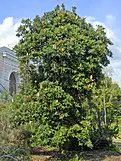Die Rote Bete, auch Rote Beete[1] (S'ouvre dans une nouvelle fenêtre)[2] (S'ouvre dans une nouvelle fenêtre) (von lateinisch (S'ouvre dans une nouvelle fenêtre) beta, Rübe, im 17. Jahrhundert aus dem Nd. (S'ouvre dans une nouvelle fenêtre) übernommen) oder Rote Rübe, in der Schweiz (S'ouvre dans une nouvelle fenêtre) Rande, in einigen Teilen Österreichs (S'ouvre dans une nouvelle fenêtre), Bayerns (S'ouvre dans une nouvelle fenêtre) und Südbadens (S'ouvre dans une nouvelle fenêtre) auch Rahne[3] (S'ouvre dans une nouvelle fenêtre) (Rauna, Rana, Rahne, Rohne, Rone, Ronen, Randig, Randich, Rohna) genannt, ist eine Kulturform der Rübe (S'ouvre dans une nouvelle fenêtre) und gehört zur Familie der ... Fuchsschwanzgewächse (S'ouvre dans une nouvelle fenêtre) (Amaranthaceae s. l., inklusive Gänsefußgewächse). Alle Kulturrüben werden heute in der Unterart Beta vulgaris subsp. vulgaris zusammengefasst, die Rote Bete zählt zur Conditiva-Gruppe (S'ouvre dans une nouvelle fenêtre).[4] (S'ouvre dans une nouvelle fenêtre) Frühere Synonyme (S'ouvre dans une nouvelle fenêtre) sind Beta vulgaris subsp. rapacea[5] (S'ouvre dans une nouvelle fenêtre) und Beta vulgaris subsp. vulgaris var. conditiva.[6] (S'ouvre dans une nouvelle fenêtre)
From today's featured article
Banksia serrata (S'ouvre dans une nouvelle fenêtre), the old man banksia, is a species of woody shrub (S'ouvre dans une nouvelle fenêtre) or tree in the family Proteaceae (S'ouvre dans une nouvelle fenêtre). It is found from Queensland (S'ouvre dans une nouvelle fenêtre) to Victoria (S'ouvre dans une nouvelle fenêtre), commonly growing as a gnarled tree up to 16 m (50 ft) in height, though it can be much smaller in more exposed areas. It has wrinkled grey bark and shiny dark green serrated leaves. The large yellow or greyish-yellow flower spikes (S'ouvre dans une nouvelle fenêtre) turn grey as they age, and pollinated flowers develop into large, grey, woody seed pods (S'ouvre dans une nouvelle fenêtre). This Banksia (S'ouvre dans une nouvelle fenêtre) species is one of four collected by Joseph Banks (S'ouvre dans une nouvelle fenêtre) in 1770, and one of four published in 1782 as part of Carl Linnaeus the Younger (S'ouvre dans une nouvelle fenêtre)'s original description of the genus. Throughout its range, it grows exclusively in sandy soils, and is usually the dominant plant where it grows in scrubland (S'ouvre dans une nouvelle fenêtre) or low woodland (S'ouvre dans une nouvelle fenêtre). B. serrata is pollinated (S'ouvre dans une nouvelle fenêtre) by and provides food for a wide array of vertebrate (S'ouvre dans une nouvelle fenêtre) and invertebrate (S'ouvre dans une nouvelle fenêtre) animals in the autumn and winter months. It is a common plant of parks and gardens. (Full article... (S'ouvre dans une nouvelle fenêtre))
